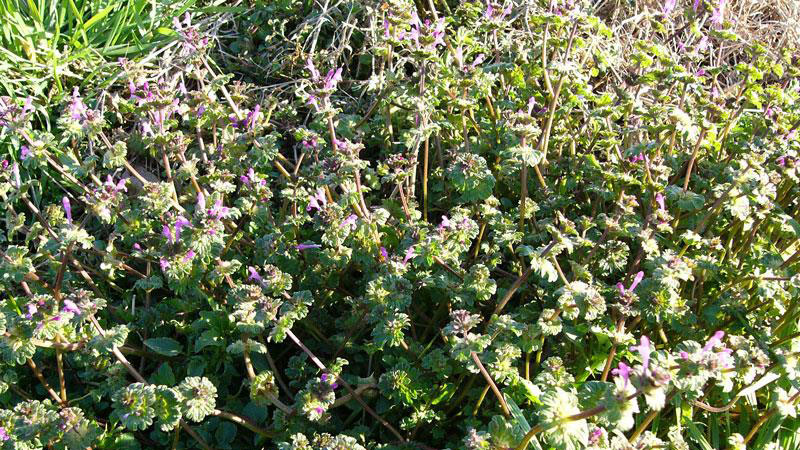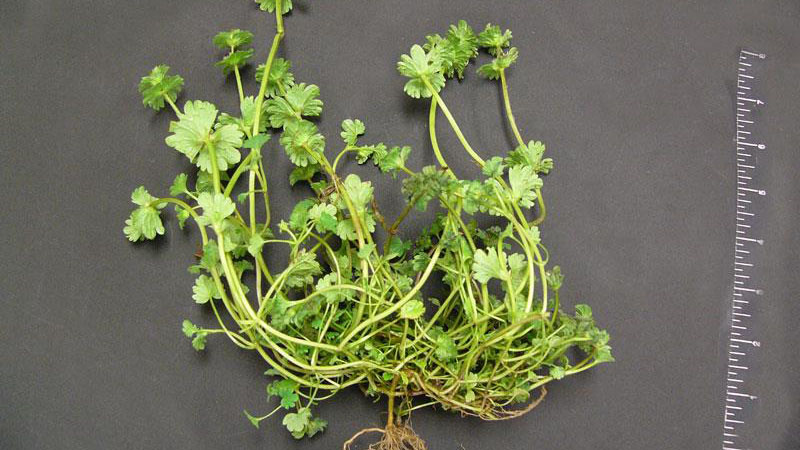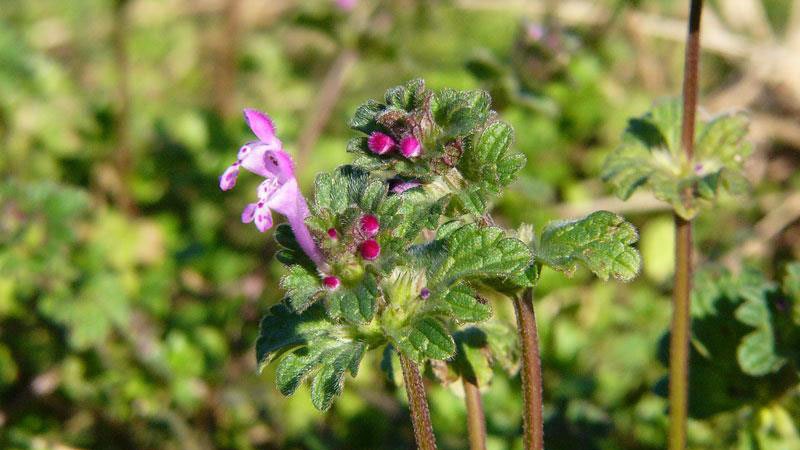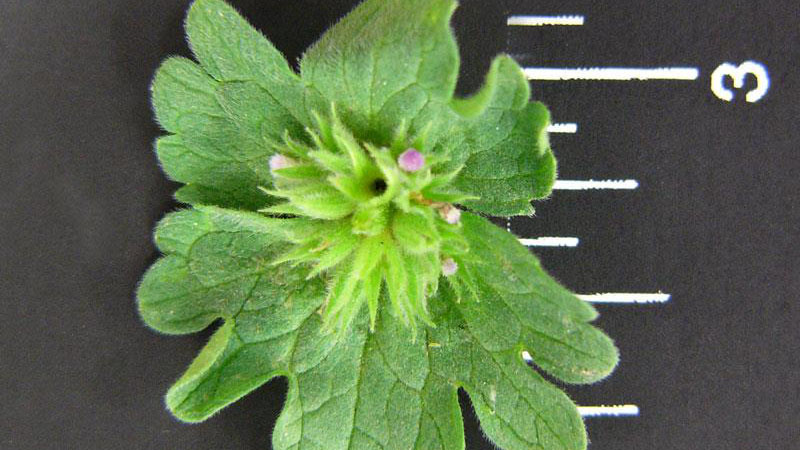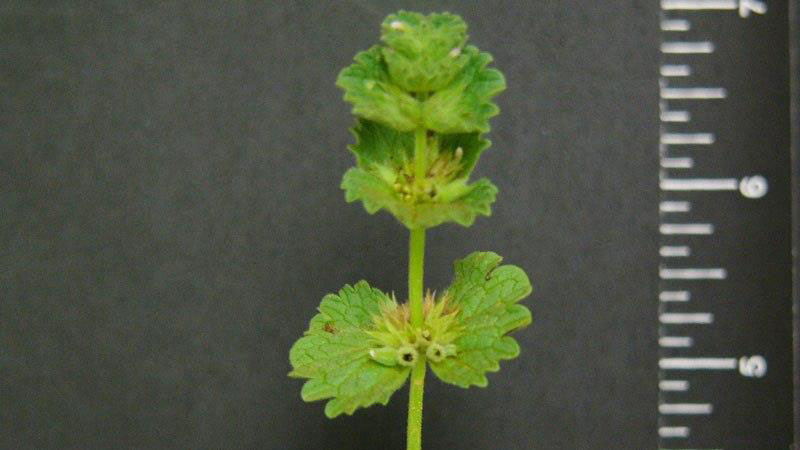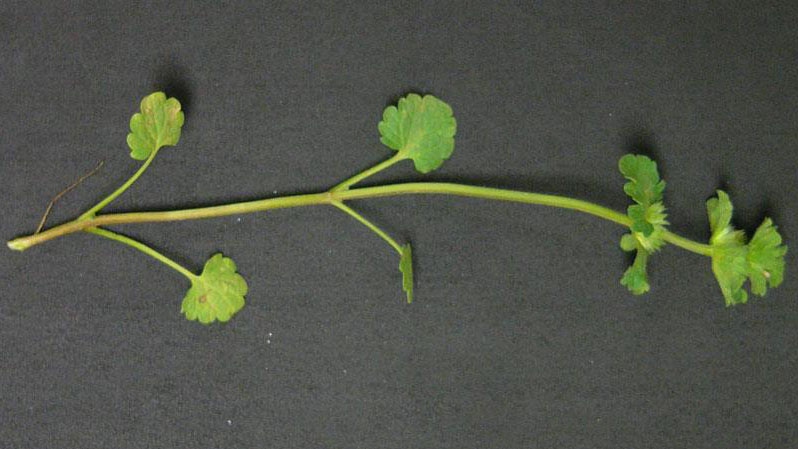Description
Henbit is a common winter annual or biennial weed found in North Carolina waste areas. Stems grow primarily upright but can root at the lower nodes. It branches freely from the base stems which are green or purple in color. Leaves are rounded, coarsely toothed, hairy, and deeply veined. Flowers are in whorls in the axils of the upper leaves. Petals are purple and fused into a two-lipped tube. It is similar to purple deadnettle in appearance but its upper leaves do not have petioles, whereas purple deadnettle's do. Purple deadnettle also has upper leaves that are distinctly red- or purple-tinged. Purple deadnettle and henbit both have distinctive four-sided (square) stems, and flower in early spring.
Cultural Control
Winter annual broadleaf weeds germinate in the fall or winter and grow during any warm weather, which may occur in the winter, but otherwise remain somewhat dormant during the winter. They resume growth and produce seed in the spring and die as temperatures increase in late spring and early summer. They quickly invade thin turf areas especially where there is good soil moisture. Shade may also encourage growth. Many have a prostrate growth habit and are not affected by mowing. A dense, vigorous turf is the best way to reduce the encroachment of winter annual weeds. First, select adapted turfgrass cultivars for your area and then properly fertilize, mow, and water to encourage dense growth.
Chemical Control
| Herbicide and Formulation | Amount of Formulation per 1,000 sq ft | Amount of Formulation per Acre | Pounds Active Ingredient per Acre | |
|---|---|---|---|---|
| Preemergence and Postemergence Control | ||||
| mesotrione, MOA 27 (4 SC) (Tenacity) | 0.092 to 0.183 fl oz | 4 to 8 fl oz | 0.125 to 0.25 | |
| Precaution and Remarks: Use on residential turf, golf courses (not greens) and sod farms for pre- and postemergence weed control. Tolerant turfgrasses include St. Augustinegrass, centipedegrass, tall fescue, fine fescue, Kentucky bluegrass, and perennial ryegrass. Add a nonionic surfactant and repeat application after 2 to 3 weeks for improved postemergence control. Tank mix with prodiamine 65 WG for extended preemergence grassy weed control. Can be applied at seeding to all tolerant grasses except fine fescue. After turf germination, wait 4 weeks or until turf has been mowed twice before making a postemergence application. Also controls henbit, chickweed, dandelion, white clover, Florida betony, Florida pusley, ground ivy, oxalis, wild violet, creeping bentgrass, and yellow nutsedge. | ||||
| [sulfentrazone + prodiamine], MOA 14 + 3 (4 SC) (Echelon) | 0.184 to 0.826 fl oz | 0.5 to 2.25 pt | 0.25 to 1.125 | |
| Precaution and Remarks: For use in residential and institutional lawns, athletic fields, sod farms, golf course fairways and roughs, roadsides, utility right-of-ways, railways, and industrial areas. Apply to turf following a second mowing if a good root system has been established. Apply up to 12 fluid ounces per acre to bentgrass at 0.5 inch or higher, fine fescue, and perennial ryegrass. Apply 18 to 24 fluid ounces per acre to perennial bluegrass, tall fescue, and all warm season grasses except St. Augustinegrass (do not apply) and bermudagrass (apply 18 to 36 fluid ounces per acre). For sod production, apply 6 months after establishment, and do not harvest within 3 months. Do not apply with adjuvants or surfactants. [Sulfentrazone + prodiamine should not be applied to cool-season turf with N-containing fertilizers unless some short-term discoloration is tolerable. | ||||
| Postemergence Control | ||||
| [thiencarbazone + foramsulfuron + halosulfuron], MOA 14 + 2 + 2 (60.5 WG) (Tribute Total) | 0.0735 oz | 3.2 oz | 0.121 | |
| Precaution and Remarks: Apply to well-established residential and commercial bermudagrass and zoysiagrass (Emerald, Meyer, Zeon) lawns, golf courses (excluding greens), athletic fields, sod farms, roadsides, parks, cemeteries and recreational areas. Do not exceed 3.2 ounces per acre per application or 6.4 ounces per acre yearly. Use 0.25 to 0.5% by volume nonionic surfactant or 0.5 to 1% by volume methylated seed oil. After application, wait 12 weeks to overseed ryegrass or bermudagrass. Wait 1 month after bermudagrass seedling emergence and 2 weeks after sprigging or sodding bermudagrass before treating. Temporary stunting and yellowing may last up to 2 weeks but turf will recover. Crabgrass and goosegrass are controlled up to 2 tiller stage. | ||||
| dicamba, MOA 4 (4 SL) (Banvel) | 1 to 2 tsp | 0.5 to 1 pt | 0.25 to 0.5 | |
| Precaution and Remarks: Apply as foliar spray to growing weeds. Prevent injury to ornamentals. Avoid rooting zone of shallow-rooted trees and shrubs. | ||||
| diglycolamine, MOA 4 (4 SL) (various brands) | 1 to 4.5 tsp | 0.5 to 2 pt | 0.25 to 1 | |
| Precaution and Remarks: Do not exceed 1 pint per acre on bentgrass, carpetgrass, buffalograss, and St. Augustinegrass. Apply to newly seeded grasses after the second mowing. Do not exceed 0.25 pint per acre on extended sensitve plant roots on sandy soils and 0.5 pint per acre on clay soils. | ||||
| [2,4-D amine + fluroxypyr + dicamba], MOA 4 + 4 + 4 (4 SL) (various brands) | 0.36 to 1.1 fl oz | 1 to 3 pt | 0.5 to 1.5 | |
| Precaution and Remarks: Use on perennial bluegrass and ryegrass, tall fescue, creeping bentgrass (excluding greens and tees), bermudagrass species, bahiagrass, zoysiagrass, and St. Augustinegrass in residential, industrial, and institutional lawns, parks, cemeteries, athletic fields, golf courses, and sod farms. Use on St. Augustinegrass sod farms only. Apply 1 to 2 pints per acre on creeping bentgrass and 1.5 to 1.8 pints per acre on warm season turf grown for sod. Apply 2 to 3 pints per acre to all other turf areas. For non-turf areas, rate can be increased to 2 to 5 pinst per acre. Application can be made to grass seedlings after second mowing and to newly sodded, sprigged, or plugged grasses 3 to 4 weeks after operations. | ||||
| [MCPA amine + fluroxypyr ester + dicamba], MOA 4 + 4 + 4 (4.8 SL) (Change Up) | 0.73 to 1.1 fl oz | 2 to 3 pt | 1.2 to 1.8 | |
| Precaution and Remarks: Same turf tolerances and uses as [2,4-D amine + fluroxypyr + dicamba] in addition to centipedegrass. Only spot treat St. Augustinegrass when temperature exceeds 80 degrees F. Do not apply more than two applications per year totaling 3 pints per acre. For non-turf areas, rate can be increased to 2 to 5 pints per acre. Application can be made to grass seedlings after second mowing and to newly sodded, sprigged, or plugged grasses 3 to 4 weeks after operations. Sod farm rates include 1.25 pints per acre for creeping bentgrass, 2 to 3 pints per acre for all other cool season grasses listed on label and 1.5 to 1.8 pints per acre for all warm season grasses listed on label. | ||||
| triclopyr + clopyralid, MOA 4 + 4 (3 SL) (various brands) | 0.37 to 0.74 fl oz | 1 to 2 pt | 0.28 to 0.56 + 0.09 to 0.19 |
|
| Precaution and Remarks: Do not apply to home lawns. May be used on centipedegrass, bermudagrass, zoysiagrass, tall fescue, creeping red fescue, chewing fescue, Kentucky bluegrass, perennial ryegrass. Repeat treatment may be necessary for prostrate spurge and wild violet. Quali-Pro formulation: maintain 0.5 inch height for warm season turf. Do not apply to bermudagrass sod farms. Wait 3 weeks to reseed. Do not use grass clippings for compost or mulch. | ||||
| [MCPA ester + triclopyr ester + dicamba], MOA 4 + 4 + 4 (3.6 EC) (various brands) | 0.91 to 1.29 fl oz | 2.5 to 3.5 pt | 1.125 to 1.575 | |
| Precaution and Remarks: May be applied to home lawns by a commercial applicator. Not for use on turf grown for resale or other commercial use as sod or seed production. Use on perennial bluegrass, ryegrass, fescue species, bentgrass (excluding greens and tees), bermudagrass, zoysiagrass, and bahiagrass. Do not apply to seedling grasses until well established. Wait 3 to 4 weeks after application to seed. | ||||
| [MCPA amine + triclopyr amine + dicamba], MOA 4 + 4 + 4 (4.56 L) (various brands) | 0.73 to 1.1 fl oz | 2 to 3 pt | 1.14 to 1.71 | |
| Precaution and Remarks: | ||||
| [MCPA amine + fluroxypyr ester + triclopyr amine], MOA 4 + 4 + 4 (3.41 L) (Battleship III) | 0.37 to 1.47 fl oz | 1 to 4 pt | 0.42625 to 1.705 | |
| Precaution and Remarks: Apply by a commercial applicator to residential, industrial, and institutional lawns, sod farms, parks, cemeteries, athletic fields, roadsides, and golf courses excluding greens and tees. May apply to bentgrass, Kentucky bluegrass, perennial ryegrass, fescue species, bahiagrass, bermudagrass, centipedegrass, and zoysiagrass. Do not spray on warm season turf less than 0.5 inch and do not exceed 3 pints per acre. Generally apply 3 to 4 pints per acre except on fairway bentgrass, which can only tolerate 2 pints per acre. Wait 3 to 4 weeks after application to reseed. Check label for spray adjuvant recommendation. | ||||
| carfentrazone-ethyl, MOA 14 (1.9 EW) (various brands) | 0.0126 to 0.048 fl oz | 0.55 to 2.1 fl oz | 0.008 to 0.031 | |
| Precaution and Remarks: May be applied to bahiagrass, bermudagrass, buffalograss, centipedegrass, St. Augustinegrass, zoysiagrass, Kentucky bluegrass, tall fescue, fine fescue, perennial ryegrass, and bentgrass. To expand the weed spectrum and extend control of the weeds listed here and on the label, carfentrazone-ethyl can be tank mixed with the entire range of phenoxy products—amines, esters, and other salts—and is also compatible with dicamba, atrazine, glyphosate, glufosinate, clopyralid, triclopyr, and MSMA. When applied alone, add 0.12 to 0.25% nonionic surfactant. | ||||
| [carfentrazone + 2,4-D ester + MCPP + dicamba], MOA 14 + 4 + 4 + 4 (2.2 EC) (Speed Zone) | 0.75 to 1.8 fl oz | 2 to 5 pt | 0.55 to 1.375 | |
| Precaution and Remarks: May be used on annual and perennial bluegrass, annual and perennial ryegrass, tall and fine fescue, creeping and colonial bentgrass, common and hybrid bermudagrass, and zoysiagrass. For use in ornamental turf, golf courses, lawns, sod farms, cemeteries, and parks. Optimum results when applied when temperatures are between 45 and 75 degrees F but may be applied up to 90 degrees F. Lower rates may be used in cooler weather. Rainfast within 3 hr and may reseed after 2 week. May apply 3 to 4 wk after sodding, sprigging, or plugging. Also may be used on bahiagrass, buffalograss, St. Augustinegrass, centipedegrass, seashore paspalum, and kikuyugrass. May reseed after 1 week. | ||||
| [carfentrazone + 2,4-D ester + MCPP + dicamba], MOA 14 + 4 + 4 + 4 (0.81 EC) (Speed Zone Southern) | 0.55 to 2.2 fl oz | 1.5 to 6 pt | 0.1519 to 0.6075 | |
| Precaution and Remarks: May be used on annual and perennial bluegrass, annual and perennial ryegrass, tall and fine fescue, creeping and colonial bentgrass, common and hybrid bermudagrass, and zoysiagrass. For use in ornamental turf, golf courses, lawns, sod farms, cemeteries, and parks. Optimum results when applied when temperatures are between 45 and 75 degrees F but may be applied up to 90 degrees F. Lower rates may be used in cooler weather. Rainfast within 3 hr and may reseed after 2 week. May apply 3 to 4 wk after sodding, sprigging, or plugging. Also may be used on bahiagrass, buffalograss, St. Augustinegrass, centipedegrass, seashore paspalum, and kikuyugrass. May reseed after 1 week. | ||||
| [carfentrazone + MCPA ester + MCPP + dicamba], MOA 14 + 4 + 4 + 4 (2.91 EC) (Power Zone) | 0.75 to 2.2 fl oz | 2 to 6 pt | 0.7275 to 2.1825 | |
| Precaution and Remarks: Same precautions and turf uses as [carfentrazone + 2,4-D ester + MCPP + dicamba] 2.2 EC except cannot be applied to creeping and colonial bentgrass. | ||||
| penoxsulam + sulfentrazone + 2,4-D + dicamba (Avenue South) | 1.0 to 2.2 fl oz | 2.7 to 6 pt | 0.271 to 0.602 | |
| Precaution and Remarks: May be used on established Kentucky bluegrass, annual bluegrass, perennial ryegrass, annual ryegrass, tall fescue, common and hybrid bermudagrass, zoysiagrass, centipedegrass, and seashore paspalum. Do not apply more than 2.7 pints per acre on fescue or perennial ryegrass unless turf injury can be tolerated. Do not apply more than 3.5 pints per acre on St. Augustinegrass unless injury, discoloration, stunting, and thinning can be tolerated. | ||||
| [sulfentrazone + 2,4-D amine + MCPP + dicamba], MOA 14 + 4 + 4 + 4 (2.18 SL) (Surge) | 0.92 to 1.84 fl oz | 2.5 to 5 pt | 0.68 to 1.36 | |
| Precaution and Remarks: Apply 2.5 to 3.25 pints per acre on warm season turf including bermudagrass species, zoysiagrass, bahiagrass, and buffalograss. Apply 3.25 to 4 pints per acre on cool season turf including species of bluegrass, ryegrass, fescue, and bentgrass (excluding greens and tees). 4 to 5 pints per acre needed to control corn speedwell and wild violet. Turf areas include residential, ornamental, institutional, and sod farms. Apply to grass seedlings after second mowing. Apply to sodded, sprigged, or plugged areas 3 to 4 weeks after operations. Treated areas may be reseeded 3 weeks after application. | ||||
| [triclopyr ester + sulfentrazone + 2,4-D ester + dicamba], MOA 4 + 14 + 4 + 4 (2.51 EC) (Tzone SE) | 0.75 to 1.5 fl oz | 2 to 4 pt | 0.628 to 1.26 | |
| Precaution and Remarks: Apply 2 to 2.25 pints per acre on fully dormant bermudagrass, zoysiagrass, and bahiagrass. Apply 3.25 to 4 pints per acre on annual and perennial bluegrass and ryegrass, and tall, red, and fine fescue. Rainfast within 3 hours. Approved turf areas include residential, ornamental, institutional, noncropland, and sod farms. Apply to grass seedlings after the second or third mowing. Apply to sodded, sprigged, or plugged areas 3 to 4 weeks after operations. Treated areas may be reseeded 3 weeks after application. | ||||
| pyraflufen ethyl, MOA 14 (0.177 SC) (Octane 2% SC) | 0.016 to 0.092 fl oz | 0.7 to 4 fl oz | 0.000938 to 0.0055 | |
| Precaution and Remarks: Used in established sod farm and ornamental turf by commercial applicators and professional landscapers only. Turf can be newly seeded, sodded, or sprigged as long as it is established and not under stress. Tolerant turfgrasses include bermudagrass, centipedegrass, St. Augustinegrass, zoysiagrass, tall fescue, perennial ryegrass, perennial bluegrass, and creeping bentgrass (not greens or tees). Apply 1 to 4 fluid ounces alone to 3- to 6-inch tall weeds. For larger weeds and broader spectrum control, apply 0.75 to 1.5 fluid ounces and tank mix with 2,4-D, mecoprop, dicamba, chloroprop, MCPA, triclopyr, or fluroxypyr. | ||||
| metsulfuron, MOA 2 (various brands) | 0.003 to 0.02 oz | 0.125 to 1 oz | 0.005 to 0.038 | |
| Precaution and Remarks: May be applied to established bermudagrass, zoysiagrass (Meyer or Emerald), St. Augustinegrass, Kentucky bluegrass or fine fescue. Do not apply to turf less than 1 year old. Do not exceed 0.5 ounces per acre on centipedegrass, fine fescue, or Kentucky bluegrass. See label for a complete list of weeds controlled. The addition of 0.25% nonionic surfactant will enhance control. May be used for removal of perennial ryegrass from overseeded warm-season turf species. For bahiagrass control, use 0.25 to 0.75 ounces per acre after spring greenup but before seedhead development. A repeat treatment may be necessary in 4 to 6 weeks. | ||||
| metsulfuron, MOA 2 (60 WDG) (Patriot 60 WDG) | 0.007 to 0.046 oz | 0.33 to 2 oz | 0.012 to 0.075 | |
| Precaution and Remarks: Apply to unimproved industrial turf only. Use maximum of 0.5 ounces per acre for fescue and bluegrass and 2 ounces per acre for bermudagrass. | ||||
| [metsulfuron + rimsulfuron], MOA 2 + 2 (37 WG) (Negate) | 0.0344352 oz | 1.5 oz | 0.0346875 | |
| Precaution and Remarks: See comments under postemergence annual bluegrass control. For bahiagrass control, a repeat treatment may be necessary 4 to 6 weeks after initial application. | ||||
Species Data
- GROWTH SEASON / LIFE CYCLE
- winter annual or biennial weed
- GROWTH HABIT
- LEAFLET NUMBER
- one
Figure 7
- one
- LEAF MARGIN
- LEAF HAIRS
- dense on upper surface, along the veins on lower surface
- LEAF / LEAFLET SHAPE
- heart / kidney / spade
- LEAF WIDTH
- 1⁄2 - 2 inches
- LEAF VENATION
- palmate
- LEAF ARRANGEMENT
- opposite
- ROOT TYPE
- fibrous
Figure 12
- fibrous
- FLOWER COLOR
- blue/purple
Publication date: Nov. 21, 2017
Reviewed/Revised: Sept. 14, 2022
N.C. Cooperative Extension prohibits discrimination and harassment regardless of age, color, disability, family and marital status, gender identity, national origin, political beliefs, race, religion, sex (including pregnancy), sexual orientation and veteran status.

